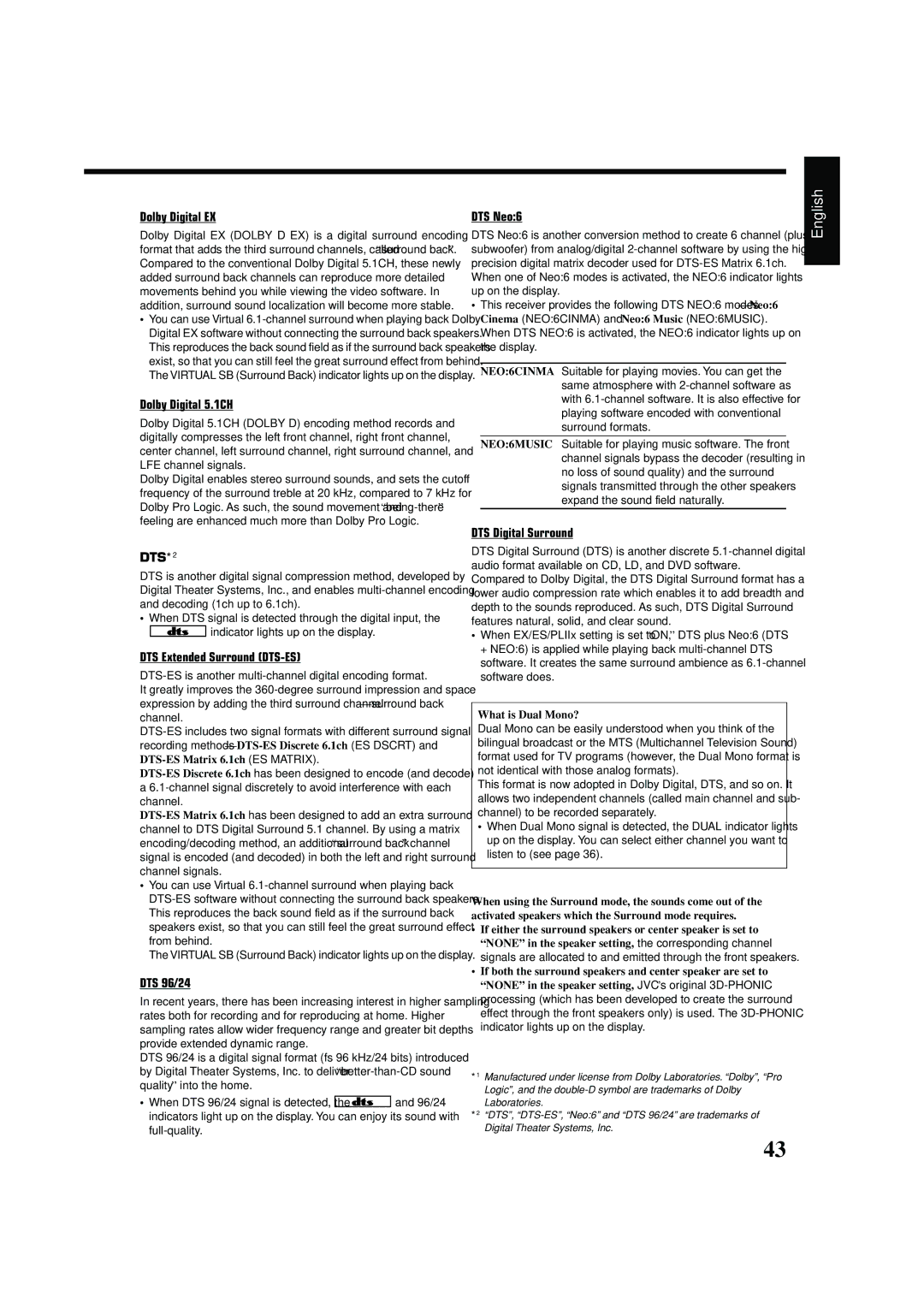Dolby Digital EX
Dolby Digital EX (DOLBY D EX) is a digital surround encoding format that adds the third surround channels, called “surround back.” Compared to the conventional Dolby Digital 5.1CH, these newly added surround back channels can reproduce more detailed movements behind you while viewing the video software. In addition, surround sound localization will become more stable.
•You can use Virtual 6.1-channel surround when playing back Dolby Digital EX software without connecting the surround back speakers. This reproduces the back sound field as if the surround back speakers exist, so that you can still feel the great surround effect from behind. The VIRTUAL SB (Surround Back) indicator lights up on the display.
Dolby Digital 5.1CH
Dolby Digital 5.1CH (DOLBY D) encoding method records and digitally compresses the left front channel, right front channel, center channel, left surround channel, right surround channel, and LFE channel signals.
Dolby Digital enables stereo surround sounds, and sets the cutoff frequency of the surround treble at 20 kHz, compared to 7 kHz for Dolby Pro Logic. As such, the sound movement and “being-there” feeling are enhanced much more than Dolby Pro Logic.
DTS*2
DTS is another digital signal compression method, developed by Digital Theater Systems, Inc., and enables multi-channel encoding and decoding (1ch up to 6.1ch).
•When DTS signal is detected through the digital input, the
indicator lights up on the display.
DTS Extended Surround (DTS-ES)
DTS-ES is another multi-channel digital encoding format.
It greatly improves the 360-degree surround impression and space expression by adding the third surround channel—surround back channel.
DTS-ES includes two signal formats with different surround signal recording methods—DTS-ES Discrete 6.1ch (ES DSCRT) and DTS-ES Matrix 6.1ch (ES MATRIX).
DTS-ES Discrete 6.1ch has been designed to encode (and decode) a 6.1-channel signal discretely to avoid interference with each channel.
DTS-ES Matrix 6.1ch has been designed to add an extra surround channel to DTS Digital Surround 5.1 channel. By using a matrix encoding/decoding method, an additional “surround back” channel signal is encoded (and decoded) in both the left and right surround channel signals.
•You can use Virtual 6.1-channel surround when playing back DTS-ES software without connecting the surround back speakers. This reproduces the back sound field as if the surround back speakers exist, so that you can still feel the great surround effect from behind.
The VIRTUAL SB (Surround Back) indicator lights up on the display.
DTS 96/24
In recent years, there has been increasing interest in higher sampling rates both for recording and for reproducing at home. Higher sampling rates allow wider frequency range and greater bit depths provide extended dynamic range.
DTS 96/24 is a digital signal format (fs 96 kHz/24 bits) introduced by Digital Theater Systems, Inc. to deliver “better-than-CD sound quality” into the home.
• When DTS 96/24 signal is detected, the | | and 96/24 |
indicators light up on the display. You can enjoy its sound with full-quality.
DTS Neo:6
DTS Neo:6 is another conversion method to create 6 channel (plus subwoofer) from analog/digital 2-channel software by using the high precision digital matrix decoder used for DTS-ES Matrix 6.1ch. When one of Neo:6 modes is activated, the NEO:6 indicator lights up on the display.
•This receiver provides the following DTS NEO:6 modes—Neo:6 Cinema (NEO:6CINMA) and Neo:6 Music (NEO:6MUSIC). When DTS NEO:6 is activated, the NEO:6 indicator lights up on the display.
NEO:6CINMA Suitable for playing movies. You can get the same atmosphere with 2-channel software as with 6.1-channel software. It is also effective for playing software encoded with conventional surround formats.
NEO:6MUSIC Suitable for playing music software. The front channel signals bypass the decoder (resulting in no loss of sound quality) and the surround signals transmitted through the other speakers expand the sound field naturally.
DTS Digital Surround
DTS Digital Surround (DTS) is another discrete 5.1-channel digital audio format available on CD, LD, and DVD software.
Compared to Dolby Digital, the DTS Digital Surround format has a lower audio compression rate which enables it to add breadth and depth to the sounds reproduced. As such, DTS Digital Surround features natural, solid, and clear sound.
•When EX/ES/PLIIx setting is set to “ON,” DTS plus Neo:6 (DTS + NEO:6) is applied while playing back multi-channel DTS software. It creates the same surround ambience as 6.1-channel software does.
What is Dual Mono?
Dual Mono can be easily understood when you think of the bilingual broadcast or the MTS (Multichannel Television Sound) format used for TV programs (however, the Dual Mono format is not identical with those analog formats).
This format is now adopted in Dolby Digital, DTS, and so on. It allows two independent channels (called main channel and sub- channel) to be recorded separately.
•When Dual Mono signal is detected, the DUAL indicator lights up on the display. You can select either channel you want to listen to (see page 36).
When using the Surround mode, the sounds come out of the activated speakers which the Surround mode requires.
•If either the surround speakers or center speaker is set to “NONE” in the speaker setting, the corresponding channel signals are allocated to and emitted through the front speakers.
•If both the surround speakers and center speaker are set to “NONE” in the speaker setting, JVC’s original 3D-PHONIC processing (which has been developed to create the surround effect through the front speakers only) is used. The 3D-PHONIC indicator lights up on the display.
*1 Manufactured under license from Dolby Laboratories. “Dolby”, “Pro Logic”, and the double-D symbol are trademarks of Dolby Laboratories.
*2 “DTS”, “DTS-ES”, “Neo:6” and “DTS 96/24” are trademarks of Digital Theater Systems, Inc.

